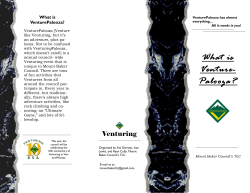
Visionary Science of the âHarvard Barbariansâ
Members of the Champlain Society pose for the camera in Cambridge, May 1881. Collection of the Mount Desert Island Historical Society Visionary Science of the “Harvard Barbarians” Catherine Schmitt It was the fifth of July, the year 1880. The forty-four-foot sloop Sunshine lay at anchor in Wasgatt Cove, where Hadlock Brook emptied into Somes Sound. On shore, in a field just north of Asa Smallidge’s house, eight young men were cutting the grass and setting up canvas tents. From the boat they unloaded shotguns and nets, fishing rods and glass bottles, small wooden 17 boxes and stacks of books and notepaper. They cut a sapling into a pole, and raised a red, white, and blue flag while cheering, “Yo-ho! Yo-ho! Yo-ho!” Over the next two months, the young men made daily excursions, on foot and by boat, around Mount Desert Island. They collected plants and birds, and dredged small animals from the mud of Somes Sound. They stared at the rocks along shore and took photographs. They could be found roaming the woods morning, noon, and night, walking along the dirt roads, a gun slung over a shoulder, a flower in hand, a camera under the arm. Under the leadership of “Captain” Charles Eliot, son of Harvard President Charles William Eliot, the students were on the Island for the summer to “do some work in some branch of natural history or science.” They called the camp Pemetic, after the native Wabanaki name for the place, and called themselves the Champlain Society, after the European explorer who renamed Mount Desert Island in 1604. They would be just as lofty in their goals and dedicated in their service to the landscape.1 On the surface, the members of the Champlain Society wouldn’t appear to be outliers. As white males from the Northeast, as Harvard students, they were among the entitled and the powerful. “Judged by the color of their skin, the churches they attended, the number of syllables in their names, by almost any such criteria, they were as homogenous an assembly of young men—and as unrepresentative of turbulent, polyglot, post-Civil War America—as one could imagine.”2 Many college students spent their summer vacation in the mountains of New England or flocked to coastal resorts. But on deeper examination, the Champlain Society members stand apart—from other Mount Desert Island tourists, other students, and other scientists—for several reasons. First, they were unique among Mount Desert Island tourists for their scientific view of the landscape and the way they experienced it, by camping. Second, they were unique among students for conducting science on their own, in the field, during summer vacation and the school year. Third, they were unique among scientists of the era for their intensive focus on the flora and fauna of a single place. Finally, all of these unique aspects combined in the Champlain Society’s enduring influence on the Mount Desert Island of today. Camping on Mount Desert There is nothing unique about camping. Tents have been a part of human life as long as there have been humans, from early Neanderthals to traveling gypsies, warriors, and explorers to soldiers and their encampments.3 Native Americans, of course, had been “camping” on and around 18 Mount Desert Island for centuries. European colonization decimated the native Wabanaki population with war, disease, and displacement. Their way of life greatly eroded, the native people continued to camp seasonally at Swan’s Island, Clark’s Point in Southwest Harbor, Saddleback Island, Pretty Marsh, Eagle Island, and Bar Harbor in the nineteenth century.4 The first tourists, the artists and their associates, lodged in private homes, taverns, and boarding houses. After the Civil War, most visitors could afford to stay in any of the new hotels, or to build their own houses on the Camp Pemetic, 1881. Collection of the Mount Desert Island Historical Society Island; they had no need to camp. By the early 1880s, the primitiveness of the “rusticator” period had faded, although the tourist population was still relatively small.5 Rumors likely spread fast of the young Harvard naturalists camping in Asa Smallidge’s field. If the Champlain Society had been somewhat quiet in 1880 (as suggested by their journals), they made their presence known in 1881. On the evening of July Fourth, after setting up camp, “the committee on pyrotechnics gave a display to a large and enthusiastic audience from North East Harbor, in fact the whole village apparently.” Fireworks, songs, torchlight processions, and calls of “Yo! Ho!” echoed across Somes Sound throughout the summer. Protected on the landward side, but exposed to the water, the Champlain Society reached the villages of Somesville and Southwest Harbor by sailing or rowing across the Sound. To get to Northeast Harbor, 19 they walked southeast along dirt paths or through the woods from Lower Hadlock Pond. Visitors to Camp Pemetic were always worthy of mention, especially when the young men were caught unprepared: wearing “old trousers,” without waistcoat, white shirt, starched collar, or necktie. They were not fancy tourists out to impress one another. They wore the rougher appearance of field scientists. In 1882, the Champlain Society decided not to hire a cook, due to the expense, and so were forced to move their camp closer to amenities so they could take their meals “at some convenient farmhouse.” They established Camp Asticou at the head of Northeast Harbor near the inn of A. C. Savage, where they ate meals for $5.00 per week. This location was closer to the Eliots’ new home— the “Ancestral Mansion”—on the eastern shore of the harbor, where young Charles and Sam could usually be found when not visiting camp or joining Champlain Society members on walks and sails. The relocation made the Champlain Society more visible. They regretted the arrival of boarders at Savage’s and the subsequent loss of privacy that left them “not alone in their glory as they would wish.” On July 12, 1882, just a few days after establishing camp, Charles Townsend “built a rootless hedge to protect the front of the tent and his matchless beard from the gaze of curious passers on the road.” That week’s edition of the Mount Desert Herald announced, “The yacht Sunshine has arrived with the ‘Harvard boys’ and they have struck tent at the head of the Harbor in the field of Capt. A. C. Savage.”6 Later camp log entries describe encounters with tourists: Sunday July 23th . . . A little incident deserves mention in this log: While Spelman was alone in camp this afternoon a buckboard passed by on the road. Said a lady to the driver, ‘Why, what is this camp here?’ ‘It is the Harvard camp; the camp where the Harvard boys are staying,’ replied the driver. ‘Harvard boys! rather Harvard barbarians!’ said the lady. It has come to this at last, - if we do not live at Bar Harbor, or at least in a hotel we are called barbarians! Probably the lady was thinking of the derivation of the word, and applied it to Townsend, for his beard is becoming more like a forest, and less like stunted scrub growth every day. . . . Sunday July 30th . . . This afternoon the conduct of many of the buckboarders was most unseemly. The 20 campers were fairly driven into the parlor tent by the frantic demonstrations of one buckboard, and soothed by the sweet singing of another party that stopped in front of the camp while singing, and then informed us that the music was not intended for our benefit. Such conduct in strangers shocks the camp very much. . . . Friday, August 25th . . . At six o’clock when all had returned to camp, and were preparing for supper, two buckboards came along the road and stopped opposite the camp. All the campers rushed forth and gazed in wonder. Rand then discovered friends on board, and went forth to receive them. Then a mighty panic seized the others. Not withstanding they were in full view of the visitors, Prentiss and Dickinson rushed down the bank, tumbled into a boat, and rowed across the harbor. The others tried to hide behind the beds and trunks in tent No. I, but finally closed the tent entirely. S.A. Eliot, however, came forth like a man, and helped Rand receive the visitors. Spelman and Townsend remained imprisoned until the departure of the buckboards. The latter was so much alarmed at one time that he threatened to prepare for bed to prevent himself from being seen by the young ladies. . . . The visitors, except the too utterly swell young men, appeared very much pleased with all they saw. One of the young ladies covered the “handsome barbarian,” S.A. Eliot with great confusion by asking him, if he were the flirtatious young man of the camp. She wound up her visit by feeding Eliot and Rand with candy. Another young lady pointed to tent No. I., and with a sweet smile asked, “Do you keep animals in that tent?” — a question that Rand was unable to answer with a straight face. After the departure of the visitors the camp was left in a state of wild hilarity from which it did not recover all the evening. Clearly, other people on Mount Desert Island viewed the Champlain Society with curiosity, intrigue, and even ridicule. Camping was not on the summer visitor’s list of leisure activities, which did include “rocking,” walking, picnicking, and buckboard outings. The Camp Ice Cream Room and Lunch Bar on West Street in Bar Harbor advertised provisions available for “camping parties” in 1882,7 but 21 the restaurant was likely catering to yacht parties and others heading to the islands or more remote areas Down East, where camping was only slightly more common. Camping was typically associated with the lakes and mountains of western Maine and New Hampshire, with lumbermen and Indians, with sardine factory boys and soldiers. Recreational camping on Mount Desert Island emerged in parallel with the automobile, and it was a very different experience from that of the Champlain Society. In the 1920s, there was a limited camping area west of the athletic field in Bar Harbor, and the National Park Service developed Bear Brook campground just south and east of the race track at Morrell Park. Blackwoods Campground was developed privately by John D. Rockefeller Jr. in 1926 before being transferred to the park; Seawall was developed in the 1930s.8 The Champlain Society’s choice of accommodations had much to do with Charles Eliot’s extensive experience with both camping and sailing. He had been coming to the region since 1871, when his father first brought the family to Calf Island in Frenchman Bay. They returned every summer, with the exception of 1873 when they went to Cape Cod. Young Charles Members of the Champlain Society in Asa Smallidge’s field, Somes Sound, 1880. Collection of the Mount Desert Island Historical Society 22 Eliot’s father and stepmother went to Europe in 1880, leaving him the yacht and camping gear to use with his friends.9 College “Vacation Rambles” While the destination of Mount Desert Island may have been unusual for a camping expedition, the Champlain Society otherwise followed a trend among college students. The pedestrian summer camping trip with a group of one’s fellow students had become a well-established college pattern by mid-century. In part an attempt to make up for the lack of organized athletic programs and facilities, the Harvard “vacation ramble” was an extracurricular institution.10 For example, in the 1840s, Francis Parkman combined historical research and recreation in a series of “forest journeys” through New Hampshire, Lake Champlain, Quebec, and western Maine.11 When the elder Charles W. Eliot himself was a student at Harvard in the 1850s, he accompanied his chemistry professor Josiah Parsons Cooke on summer “walking-journeys” throughout the Northeast. They collected specimens, studied mines, foundries, and metal works, and observed “topography and the forces which have modeled the crust of the earth.”12 In 1858, James Russell Lowell, Ralph Waldo Emerson, Louis Agassiz, Jeffries Wyman, William Stillman, and other men associated with Harvard established “The Philosphers Camp” at Follansbee Pond in the Adirondacks, “each member enjoying the freedom of the country, having his own guide and boat, and exploring on his own account or remaining at camp headquarters at pleasure.”13 Informed by regional guidebooks and manuals such as The Art of Travel by Francis Galton (1855) or John Gould’s How to Camp Out (1877),14 New England college students dispatched to the mountains, which offered “healthful vigor to the body, and beauty of scenery for the eye,” kindling “the noblest aspirations of the soul.”15 Trips to the Adirondacks, White Mountains, or Moosehead Lake involved hunting and fishing, and sometimes camping and canoeing, while coastal excursions were more likely to feature “waltzing and flirting,” “sentimental songs,” and “sitting by moonlight on rocks whose base the sea washes with lazy murmuring.”16 These outdoor pursuits resulted from several converging cultural phenomena, the most influential being the Romantic movement’s transformation of wilderness from a dark dangerous forest cleared by the pioneer to a picturesque and sublime (though temporary) alternative to urban civilization. By the 1840s, it was commonplace for writers and artists to make periodic excursions into the wilds, collect “impressions,” 23 and return home to publish and paint, advertising wilderness destinations to the masses eager to escape the city. Indeed, the capacity to appreciate wilderness was deemed one of the qualities of a gentleman.17 For urban males especially, caught up in the rising industrial economy and made soft by technology and modern comforts, the wilderness vacation was a tonic, and camping provided a sense of connection to an American tradition.18 Science, however, was not typically a part of these vacation rambles. At the Philosopher’s Camp, scientific topics featured in the fireside lectures of Agassiz and Wyman, who also did some collecting, but science was not the focus of the vacation. Harvard Magazine advised students in 1859 to look away from their books during summer break: “Let us abjure study during vacation as heartily as we pursue it in term-time. . . . ”19 Their sense of purpose and scientific perspective differentiated the Champlain Society from their rambling peers and from other summer visitors to Mount Desert Island. Descriptions of summer vacations in Harvard Magazine, the Harvard Crimson, and elsewhere do not reveal much scientific activity among students outside of campus. Certainly, there were other students conducting science in the summer at other places and times (e.g., Charles William Eliot, above; and William Stimpson and Nathaniel Shaler, below). But on Mount Desert Island in the 1880s, the members of the Champlain Society were setting the example for future students. Of course they participated in social activities, but they also took their scientific work seriously. To show energy in one’s subject area was praiseworthy. At the close of the 1882 season at Asticou, the journal-keeper noted, There is an impression among members of the Society that little or no work was done during the summer, an impression that is on the whole erroneous. In every department represented good work was done by some member or members, and there was not very much more loafing, comparatively speaking, than in 1881. We must remember that some of our members were born to enliven us socially, not to drudge over scientific work! Back at Harvard during the school year, they shared reports and reminisced about the past summer’s work, and planned future seasons. “Five hundred species in four years is not very much to boast of, perhaps, but they give us a good nucleus for future work,” reported Edward Lothrup Rand, secretary and chair of the Botanical Department, in 1883. They presented their work before both the Boston and Harvard natural history societies. 24 With varying membership but with Charles Eliot always their “Captain,” the Champlain Society returned to Mount Desert each summer throughout the next decade, in the process compiling the first intensive natural history surveys of the Island, including plants, birds, insects, fish, and marine invertebrates. Their geology professor, William Morris Davis, joined them at the camp in 1880 and 1881, but the students organized the expeditions and resulting scientific work themselves. The Champlain Society was focused on science at a time when only about 30 percent of students took a course in natural history.20 Were they among the small minority of Harvard students in 1880 who were known as “digs”—social outcasts because they insisted on taking their studies seriously, worked hard, and made no effort to conceal their academic ambitions?21 Were they nerds? They did not belong to the “high set,” the “club crowd.” Certainly, Charles Eliot stood out for being the son of the college president, but this probably only contributed to his unpopularity. Place-based Science Hark, the sound of song comes faintly from the distance, and we hear Louder growing every moment the resounding C.S. cheer. The Champlain Society at work on scientific “specialties” in the parlor tent, 1881. Collection of the Mount Desert Island Historical Society 25 Here comes the scientific offerings, here come tributes gained by toil, Long reports of all knowledge gained upon Mt. Desert’s soil!22 The Champlain Society were not the first scientists to visit Mount Desert Island. Rather, they continued a relatively extensive tradition of scientific inquiry in the region. The obvious and striking geology of the Island, combined with a coastal location at the transition between temperate and boreal climate zones, created a diversity of habitats and species not found anywhere else along the Atlantic Coast, and these features, once publicized by artists and writers, attracted scientists to the region. Some of the earliest dedicated, place-based fieldwork in America took place as part of state natural history and geology surveys. Young Boston physician Charles T. Jackson conducted the first such survey of Maine in 1836, but took only a brief look around Mount Desert Island.23 Unlike the “explorernaturalists” who came before them, who observed virtually anything new and curious that crossed their path, surveyors had a practical bent. They did not study nature for its own sake, but as “an untilled garden” to be improved. Plants were described in terms of culinary and medicinal uses, trees according to their The Champlain Society surveyed the natural history of structural properties, rocks for Mount Desert Island, and each “department” recorded their minerals, and landscape its findings, as in this report from the Ichthyological features in light of military [Fisheries] Department. The flag on the cover is the 24 society’s official colors. Collection of the Mount Desert and commercial advantages. Island Historical Society So Jackson wrote in his first report, “Mt. Desert is yet but little known, and will, if explored, furnish many valuable minerals; but owing to the short time we were allowed to spend upon it, we could do no more than glance at its resources.” Charles H. Hitchcock and Ezekiel Holmes later expanded Jackson’s work as part of 26 a second statewide geological survey.25 In 1850, federal geodetic surveyors built a road and established a station on the summit of Green (now Cadillac) Mountain. Surveyors established fixed positions on land before mapping the shoreline and charting the bottom of rivers and harbors. It took them nearly a decade to complete the first detailed survey of the Island and surrounding area, which later served as the base for the mapped trail system.26 The surveyors served as a point of contact for other visiting scientists, and as a curiosity for tourists who reached the summit. Geologists such as Charles Hitchcock, John De Laski, and Louis Agassiz found on Mount Desert evidence for their theories about the forces that shaped the earth’s surface. In 1874, geologist Nathaniel Southgate Shaler came to the Island with the Coast Survey. Shaler had first visited in 1860, when he and William Stimpson,27 both students of Louis Agassiz at Harvard, made a summer dredging expedition along the eastern Maine coast. Shaler then left Stimpson and joined Harvard undergraduates Addison Emery Verrill and Alpheus Hyatt to dredge for invertebrates in Frenchman Bay. They camped at the base of Cadillac Mountain.28 Shaler became a Harvard professor of paleontology and geology and later conducted the first systematic geologic study of Mount Desert Island, with the U.S. Geological Survey.29 Botanists, marine biologists, and archaeologists all studied parts of the Island in the second half of the nineteenth century. But except for the Coast Surveyors, who were not focused on natural history, all of these people spent at most a few days or weeks on Mount Desert. The Champlain Society, in contrast, spent at least eight weeks on the Island every summer between 1880 and 1889, with Charles Eliot, Samuel A. Eliot, and Edward Rand spending even more time. They repeatedly and intensively focused on the biodiversity of a single place. They did not merely react to scenery as tourists did, viewing the mountains, lakes, and shoreline only as a sublime backdrop for picnics, walks, or sails. Nor were they just looking for things that would prove useful and profitable for humans. They were interested in the place in its entirety. They engaged with it, understanding the Island as a scene of inter-relating plants, animals, and habitat—and they understood that their observations were limited to the summer season. Their science was real. The Champlain Society left a record that twentyfirst century scientists have used to understand changes in the Island environment.30 Their studies of geology, assisted by their young professor William Morris Davis, informed what is likely the first description of 27 Mount Desert Island geology31 that could still be considered accurate today. Their departure at the end of the season was shaded by regret, the members “sorry to leave the field now become so homelike, and the view grown more beautiful through the long acquaintance.” Their “long acquaintance” gave rise to a sense of place. They did not see themselves as tourists, and lamented the spread of tourism and its effect on the Island: Mt. Desert is, in beauty and diversity of scenery, the most attractive spot on the Eastern Coast of the United States. Nowhere else can be found such a combination of strait and streamlet, bay and lake, seashore and mountain as exist in this island. Therefore it naturally has become a famous and fashionable summer resort for people from all parts of the country. While this increasing popularity of the Island means prosperity to the inhabitants, it means destruction to many of Nature’s chiefest charms. Already the woods are falling beneath the axe to give place to flimsy, barn-like hotels, the rarer wildflowers are disappearing, the ferns and mosses are torn from the spots they have so long adorned, the wood-roads are becoming dusty highways . . . the shy birds of the wood are every year being driven farther and farther into the recesses of the Island; the lakes and streams are being depopulated by the unscrupulous fisherman; the animals are either being driven away or destroyed. In such a state of things it will not be many years before all the wildness of Mt. Desert is gone forever, and in its stead we have the tinsel-glitter of a Long Branch, Coney Island, or Newport, depending on its air, its society, and its scenery to attract visitors, though even the scenery will suffer great harm in the future if the woods are destroyed, and unsightly buildings erected on beautiful sites. Perhaps I have drawn an exaggerated picture of the future of Mt. Desert, but it is often better to exaggerate than belittle the magnitude of a coming evil.32 This concern inspired the Champlain Society to advocate for conservation of Mount Desert Island. Later in the same report, Rand writes, Is it possible to protect the natural beauty of the island 28 in any way? . . . A company of interested parties could buy at a small cost the parts of the Island less desirable for building purposes. To these they could add from time to time such of the more desirable lots as they could obtain control of either by purchase or by arrangement with the proprietor. This tract of land should then be placed in the charge of a forester and his assistants; the lakes and streams should be stocked with valuable fish; the increase of animals and birds encouraged; the growth of trees, shrubs, plants, ferns and mosses cared for. This park should be free to all. . . . I hope, however that we may have the pleasure before long of listening to a paper on this subject by one of its earnest advocates, ‘Captain’ Charles Eliot. Eliot and Rand continued to advocate for conservation and, after Charles Eliot’s untimely death, his father Charles William Eliot, with George Dorr, formed the Hancock County Trustees of Reservations (modeled after an organization Charles Eliot created in Massachusetts), which acquired the first landholdings that became Acadia National Park, some thirty-six years after the Champlain Society’s first summer. Thus the Champlain Society can be linked directly to conservation on the ground. While the spirit of American conservation may have originated a century before, few scientists were actively working to protect the places they studied.33 While today their language and approach may seem dated, in their environmental sensibility the young scientists of the Champlain Society were thoroughly modern. Notes The journals, camp logs, yacht logs, and meeting records of the Champlain Society are held by the Mount Desert Island Historical Society. Reports of the Botanical Department are held by Harvard University. 2 David McCullough, Mornings on Horseback (New York: Simon and Schuster, 1981). 3 See Godfrey Rhodes, Tents and Tent-Life from the Earliest Ages to the Present Time (London: Smith, Elder, and Co., 1858). 4 There are several brief mentions in the Champlain Society logbooks of members visiting Indian encampments. The campsite in Bar Harbor, at its peak numbering 250 people in 1885, was “relocated” many times, and in 1893 Bar Harbor authorities formally banned Indian encampments on shore property by Bridge Street, shifting habitation to Ledgelawn. The Ledgelawn encampment continued into the 1920s, fell into disuse, and for several years served as a campground for park visitors. Harald E.L. Prins and Bunny McBride, Asticou’s Island Domain: Wabanaki Peoples at Mount Desert Island 1500-2000, (Boston: Northeast Region Ethnography Program, National Park Service, 2007), vol. 1. 1 29 Richard Rollins Wescott, “Economic, social and governmental aspects of the development of Maine’s vacation industry 1850-1920,” (master’s thesis, University of Maine, Orono, 1961). 6 Mount Desert Herald, July 14, 1882, 3. 7 Mount Desert Herald, July 28, 1882, 7. 8 Charles W. Eliot, “The Future of Mount Desert Island” (Bar Harbor Village Improvement Association, 1928); H. Eliot Foulds, Cultural Landscape Report for Blackwoods and Seawall Campgrounds, Acadia National Park (Boston: Olmsted Center for Landscape Preservation, 1996). Thanks to Maureen Fournier for help in researching the history of campgrounds on Mount Desert. 9 Henry James, Charles W. Eliot (Boston: Houghton Mifflin, 1930), vol. 1; Charles W. Eliot, Charles Eliot, Landscape Architect (Amherst: University of Massachusetts Press, 1999). 10 William A. Koelsch, “Antebellum Harvard students and the recreational exploration of the New England landscape,” Journal of Historical Geography 8, no. 4 (1982), 362-72. 11 Mason Wade, ed., The Journals of Francis Parkman (New York: Harper & Brothers, 1947). 12 Charles W. Eliot, “How I have kept my health and working power till eighty,” in A Late Harvest (Boston: Atlantic Monthly Press, 1924). As president, Charles William Eliot lengthened the summer vacation through September, “so that teachers and students alike might have three months for travel or to do a piece of consecutive work” (James, Charles W. Eliot, 241). 13 William J. Stillman, “The Philosophers’ Camp: Emerson, Agassiz, Lowell, and Others in the Adirondacks,” Century Illustrated 46, no. 4 (1893), 598-607. 14 Matthew De Abaitua, The Art of Camping (London: Hamish Hamilton, 2011). 15 Harvard, October 1858, 341. 16 Harvard, June 1857, 208-09. 17 Roderick Nash, Wilderness and the American Mind (New Haven: Yale University Press, 2001). 18 Leslie Paris, Children’s Nature: The Rise of the American Summer Camp (New York: New York University Press, 2008). 19 Harvard, November 1859, 46-47. 20 Harvard Crimson, May 7, 1880. 21 McCullough, Mornings on Horseback, 202-03. 22 Edward L. Rand, “Fourth Report of the Botanical Department” (Harvard University, Gray Herbarium Archives, 1883). 23 Charles T. Jackson, First Report on the Geology of the State of Maine (Augusta: Smith and Robinson, 1837). 25 Richard W. Judd, The Untilled Garden (New York: Cambridge University Press, 2009). 26 Charles H. Hitchock, “Second Annual Report upon the Natural History and Geology of the State of Maine,” in Seventh Annual Report of the Secretary of the Maine Board of Agriculture (Augusta: Stevens & Sayward, 1862), 266-90. 27 Margaret Coffin Brown, Jim Vekasi, and Olmstead Center for Landscape Preservation, et al., Pathmakers: Cultural Landscape Report for the Historic Hiking Trail System of Mount Desert Island (Boston: National Park Service & Olmsted Center for Landscape Preservation, 2006). 28 Stimpson returned in 1858 aboard the Helen of Swampscott from Boston. He and New York Times Washington correspondent Robert Carter traveled to Southwest Harbor, Bar Harbor, Otter Creek, Great Head, and Schooner Head, as detailed in Carter’s classic Summer Cruise of the New England Coast. 29 W.R. Coe, “Biographical memoir of Addison Emery Verrill, 1839-1926,” National Academy of Sciences Biographical Memoirs 14, no. 2 (1929), 19-66; N.S. Shaler, The Autobiography of Nathaniel Southgate Shaler (Boston: Houghton Mifflin, 1909). 30 N.S. Shaler, “Geology of Mount Desert,” in Eighth Annual Report of the USGS, part II, 1889. 30 See, for example, Greene et al., “Vascular flora of the Acadia National Park Region, Maine,” Rhodora 107 (2005), 117-85. 31 Located in E.L. Rand and J.H. Redfield, Flora of Mount Desert Island Maine (Cambridge: J. Wilson and Son, 1894). 5 30 E.L. Rand, Report of the Botanical Department 1880, First Annual Report (Harvard University, Gray Herbarium Archives, 1881). 33 Lawrence Farber, Finding Order in Nature: The Naturalist Tradition from Linnaeus to E.O. Wilson (Baltimore: Johns Hopkins University Press, 2000). 32 31
© Copyright 2025









